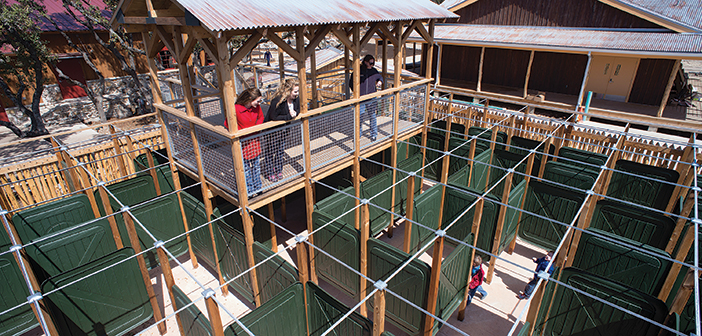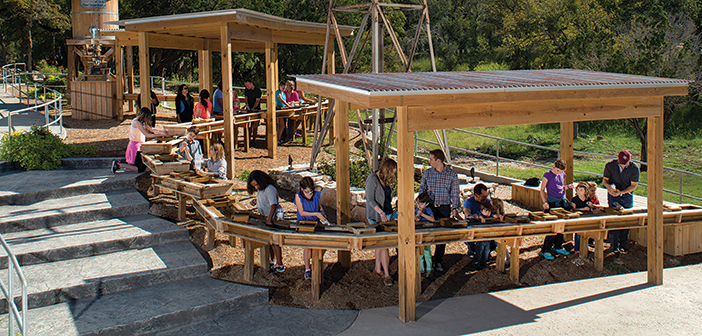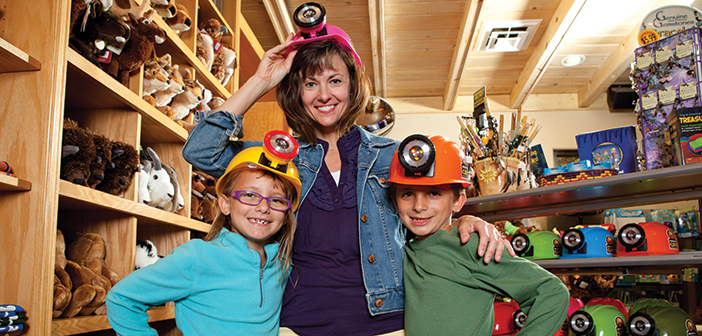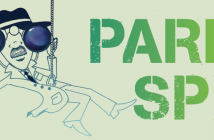They can be the three words that strike terror in the hearts of park operators far and wide.
Food. Beverage. Retail.
With all the work that goes into making a park function, thinking of ways to boost revenue can be a task. Taking on F & B and retail can sometimes seem like an insurmountable challenge. So rather than really study it and find a breakthrough solution, you purchase the water bottles, stock a few t-shirts, and go on with your day.
But here’s the thing: done right, managed with your clientele and theme in mind, F & B and retail can actually be aspects of your business that you cheer, not loathe. More and more parks are seeing their profits soar after committing to doing it right.
IF YOU CAPTURE THEM, THEY WILL SPEND
We already know that if you build it, they will come. But there’s more to that equation. Parks are adding more and more cool new activities. From zip lines at cave tours, to mountain coasters at what was once a simple scenic attraction, parks are becoming places that are not just a stop-by, but now a stay-at.
Rushmore Cave has been entertaining visitors with cave tours for 90 years. Starting in 1927, it was, for 60 years, a successful cave tour with a small gift shop. Ticket prices were the revenue, the gift shop a small swath of icing on that cake.
But over the years, something had to change. Two Federal Park cave tours were launched nearby, and they cut into Rushmore’s business. The Park tours were able to keep entry prices down, since they operated on a government budget, and Rushmore Cave started to lose business to those lower prices. Once people were able to search prices and destinations on smart phones, Rushmore Cave truly faced a battle. “We were getting killed on ticket prices,” says owner Tom Hagen.
And so Rushmore rose up. In 2008, it added Rush Mountain Adventure Park, including a zip line, mountain coaster, a cool 7-D interactive ride, and a mining activity center. Cave tours became just one of several reasons to visit. And with multiple activities, the cave wasn’t just a cool reason for people to stop by. The collection of activities meant that visitors stayed for a longer period of time, and that meant they needed—and wanted—food, beverage, and other necessities and mementos.
Hagen took his time and studied what worked (more on that in a bit). Then, in 2013, he went forward with simple, fun food offerings like ice cream, pizza and hot dogs. The result? “Our food revenues are up 300 percent since we started offering them,” he says. “Ticket sales used to be our sole driver. Not anymore.” The success of the food offerings expanded the range not only for what activities were offered, but also for what folks could spend money on at the park.

As an inclusive family activity, the maze at Natural Bridge Caverns keeps guests of all ages entertained longer, and helps increase overall spend.
At Howe Caverns in New York, operations manager Mark “Sparky” Spaulding has had a similar experience. Offering cave tours since 1920, the Caverns have long run a small restaurant and gift shop, but nothing that drove much revenue.
In 2011, high adventure was added to the operation, and almost immediately the possibility of greater F & B and retail revenue was obvious. Why? Because people started sticking around. “It wasn’t even about more people,” says Spaulding. “It was about more time.”
Still, he says, the Caverns realized via trial and error that, even though people were staying longer, services such as food offerings needed to be considerate of the guest’s time. Sit-down restaurants, while tempting, didn’t suit guests’ interests. “Simple and quick is what works,” says Spaulding. “We can actually serve more people that way, and it seems to keep them happier, too.”
At Natural Bridge Caverns in Texas, the expansion into aerial adventure and other activities came five years ago, when it added a ropes course, zip line, and most recently, a maze. Says attractions manager Mario Guittari, “Food follows the attraction. The more time spent, the more they spend on F & B. The more time they are here, the more chance they are going to have that second drink or peruse the gift shop.”
The maze, he says, doesn’t keep people at the park as long as, say, the ropes course does as a standalone activity. However, it serves an important purpose for the overall operation: it offers an inclusive activity for all, and rounds out a day of fun. “So now we have a way for families with kids of all ages and even older folks to stay longer. It’s been a great boost [to alternative source revenue],” Guittari says.
MAKE IT ALL ABOUT YOU—BUT FOR THEM
At first blush, stocking a basic retail shop and food and beverage site may seem simple: T-shirts, bottles of water, bumper stickers, etc. But the successful revenue manager finds a marriage of what customers need at that moment, and also what connects them—long term—to who you are and the experience they had. Retail isn’t just about selling stuff; it’s about selling memories.
“You know,” says Guittari, “if you go to Disney, you are going to buy a Robin Hood hat, not just a t-shirt that says ‘Orlando’ on it. When a product—food or soft goods—connects, it works.”
That’s why Spaulding has seen such great success with his park’s gemstone mining. Guests, who have just toured caves and learned about rocks and gemstones, can then purchase the opportunity to sift through sand using a sluice, and they’re promised to find a variety of gemstones. Once they’ve found some treasures (oh! the joy of discovery!), Howe Caverns offers a retail service on site where guests can make jewelry from their bounty. “People absolutely love it,” he says of the huge revenue enhancer.
Natural Bridge Caverns also has a sluice, and it is one of its biggest sellers as well. “It fits with what we do with the cave and all,” says Guittari. “And it’s like an attraction in itself—something the whole family can do that is fun and relatively inexpensive.”

The gemstone mining sluice at Natural Bridge Caverns in Texas is inexpensive fun for the entire family—and a huge seller.
According to Hagen, a wildly popular retail item at Rushmore Caves is cave helmets. “We sell a ton of them and kids love them,” he says. “Plus, they have lights and you can use them on the tour.”

Cave helmets sporting the Rushmore Caves brand fly off the shelves because they’re unique, and also useful.
The helmets have Rushmore Caves’ logo on the side, but Hagen points out the useful souvenirs are taken home with more than a brand connected to them. “They are a memory. You wore that [helmet]in that cool cave, and you always remember that.” A good lesson: choose products that match the experience.
Food can do the same thing as those helmets. The home-run products are those that build a memory of the visit as well. Natural Bridge Caverns found its golden product in a Texas brand: Blue Bell Ice Cream. And it’s proudly served in handmade waffle cones you can only get at the Caverns. So popular are the cones, it is considered an integral part of anyone’s visit. To push its “personal brand” more, the park makes its own fudge, which is also wildly popular.
“People like buying local when they are visiting somewhere,” says Guittari. “Blue Bell is a huge brand here, and our fudge, with unique flavors, like chocolate jalapeno, is something you just cannot find anywhere else. You have to have some, and take some home.” This makes a visit to the Caverns a multi-sensory memory.
Spaulding says that at Howe Caverns, gifts that match the experience work well, too. Its rock shop is successful, in part, because guests have just been educated about the products it offers, including magnetic rocks, which are huge sellers.
But that’s not the biggest seller. What flies off the shelf fastest? Sweatshirts. And not just because they are handsomely branded. “It’s 52 degrees in [the caves],” says Spaulding. “Guests forget that, so they all need them.” But despite the demand for sweatshirts, the operation offers them at a reasonable price. “We’re respectful,” he says. “We keep what they need at that moment at a reasonable price. We’ll catch them on other things. But sweats? We make it affordable for them to be comfortable.”
Plus, the major benefit of selling more clothing that sports the Howe Caverns brand is every time a guest wears his or her sweatshirt in public, the attraction is gaining organic exposure. It’s like having thousands of walking advertisements.
Hagen says he keeps his shelves stocked with simple products folks need—water and t-shirts, for instance— and makes sure all are properly branded. The water bottles sell well, and he actually uses them as promotional vehicles. “We are active in our community,” Hagen says. “We donate water to lots of events in our area, always with our logo on the bottles. It’s using one of our products to market ourselves to a new audience.”
THE KISS METHOD
KISS. Keep It Simple, Stupid. It’s an old and, well, simple, plan that works in F & B, too. Easy to purchase, easy to eat, easy to stock—that’s what makes revenue rise.
Asked for advice on how to bump sales, Hagen is to the point. “Ice cream, ice cream and ice cream,” he implores. “Everyone loves it.” He made sure to invest in a quality product, which, he says, is worth the extra cost, “so it’s a good experience.”
In addition: bottled water, fountain soda, hot dogs, and pizza. “The simplest things do the best,” he says. Same with retail.
Sometimes, to increase revenues, it’s best to give the guest something for free. Let Hagen explain: “Stickers,” he says. The Caverns has rolls of stickers at each attraction, and gives them away as each guest conquers each attraction. Free. “So they leave us and go seven miles down to Mount Rushmore carrying our name throughout the hills. They are walking advertisements for us. It’s great.”
So, now you’re convinced. You should ramp up your other sources of revenue. But how? Start by just giving it a try.
It’s easy to do, says Spaulding. Thanks to modern technology, a park can now introduce a product with a relatively low investment and low order amount. “Don’t be afraid to at least dive in and give some things a try,” he says. “Nowadays, you can buy small amounts and see how it goes. There’s so little risk, trying new things now is simple, and makes sense.”
It especially makes sense when many of those simple things do wonders for the bottom line.




